Mammals of the Adirondacks:
White-tailed Deer (Odocoileus virginianus)
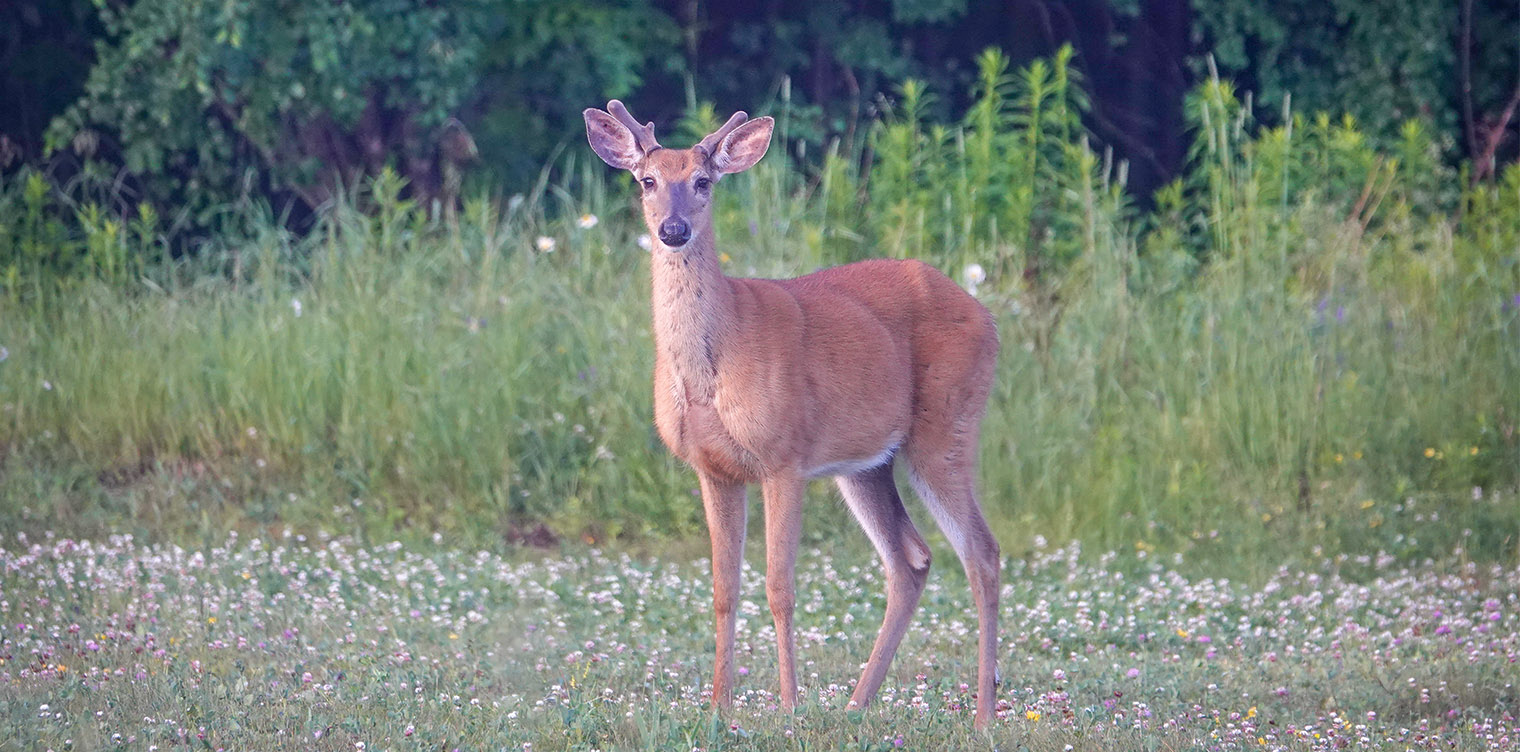
The White-tailed Deer (Odocoileus virginianus) is a selective herbivore found in a wide variety of habitats throughout the Adirondacks, but is most at home in forest edges, brushy fields, and the early successional stages of forests.
White-tailed Deer are ungulates – hoofed animals that use their toes to sustain their whole body weight when moving.
- The whitetail is one of two ungulates that are found in the Adirondacks; the other is the much-larger Moose. Both are members of the Cervidae family. Males of both species grow antlers which start to develop in the spring and are shed in winter.
- The genus name (Odocoileus) means hollow tooth, a reference to the fact that the members of this species have hollow teeth. The other member of the Odocoileus genus is the Mule Deer (Odocoileus hemionus), which looks a lot like our whitetails, but has a black-tipped tail, even bigger ears (hence the name), and lives out west.
- The species name (virginianus) refers to the area where these mammals were scientifically described. There are 38 subspecies of White-tailed Deer, including 17 occurring in North America, 13 in Mexico and Central America, and 8 in South America. Our subspecies is Odocoileus virginianus borealis (Northern White-tailed Deer).
This mammal's nonscientific name derives from its bushy tail, which has an undersurface of white hairs prominently visible when the animal erects its tail when disturbed. Other nonscientific names for the White-tailed Deer include Virginia Deer, Whitetail Deer, Whitetail, and White-tail.
White-tailed Deer: Description
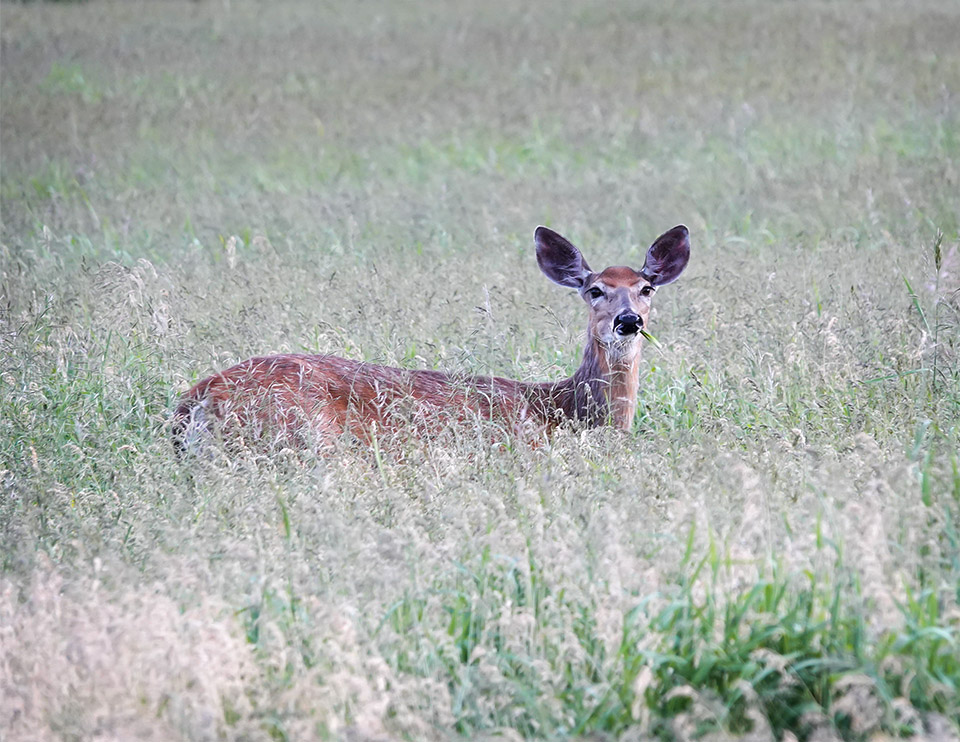
White-tailed Deer have long, slender legs, prominent ears, and large liquid brown eyes set off against thick white eye rings. Whitetails have a shiny black nose contrasting with a whitish nose-band. The chin is white and edged on either side with a wide band of dark hair. The throat area is also white or grayish.
The deer's prominent ears are edged in a dark color contrasting with white hair on the inside. The ears are often in motion; they can swivel independently of each other to capture sound from multiple directions and pinpoint the sound's exact location.
The deer's underparts, including its belly and the inner portions of its upper legs, are white. The rump and underside of the tail are also white. When alarmed, the deer flashes its tail, and the white hairs on its rump are flared out, giving rise to the name "white-tail."
In the Adirondack region and other parts of the northern hemisphere, White-tailed Deer molt twice a year. In summer, adult whitetails are reddish brown. Their coats, which can vary from red-brown to bright tan, consist of short, wiry hairs. In late summer or early autumn, the deer transition to their winter coats, which are a drabber blue-gray or gray-brown. The winter coats are longer and thicker. The hair, which is hollow, is more brittle, with a woolly undercoat to insulate the deer from the cold.
The timing of the molts apparently depends varies from year to year.
- In the Adirondack region, deer begin to lose their heavy winter coats in April; by mid-June most of our deer are sporting their red summer coats.
- Transition to the winter coat usually begins in the Adirondack region in early September.
Fawns have a bright red coat with rows of white spots along either side of the backbone and along the sides and flanks. The coloration is designed to provide camouflage, which is the fawn's main defense against its many predators. Fawns lose their spotted coats in the fall. Fawns molt slightly later than adults, in October to December, when the animals are four to six months old.
Male White-tailed Deer grow a set of bony antlers every year. Antler development begins in April and May and is usually complete by August or September, in time for the late fall breeding season.
- When the antlers emerge, they are covered with a soft coating of "velvet," with blood vessels that carry nutrients to the growing bone. This covering dries up and sloughs off when antler development is complete.
- The antlers are used as a weapon during mating season. After the mating season, they are no longer needed; and (because carrying them around expends energy) they are shed. Most male whitetails in our area will have shed their antlers by the end of the year, with a few retaining them until January or February.
Whitetails vary in size depending on the region. The smallest subspecies are found at latitudes near the equator or at low elections. The largest subspecies are found in the Northeast and Great lakes regions. Our Adirondack whitetails fall into this group. They weigh in at an average of 203 pounds for males and 155 pound for females.
White-tailed Deer: Diet
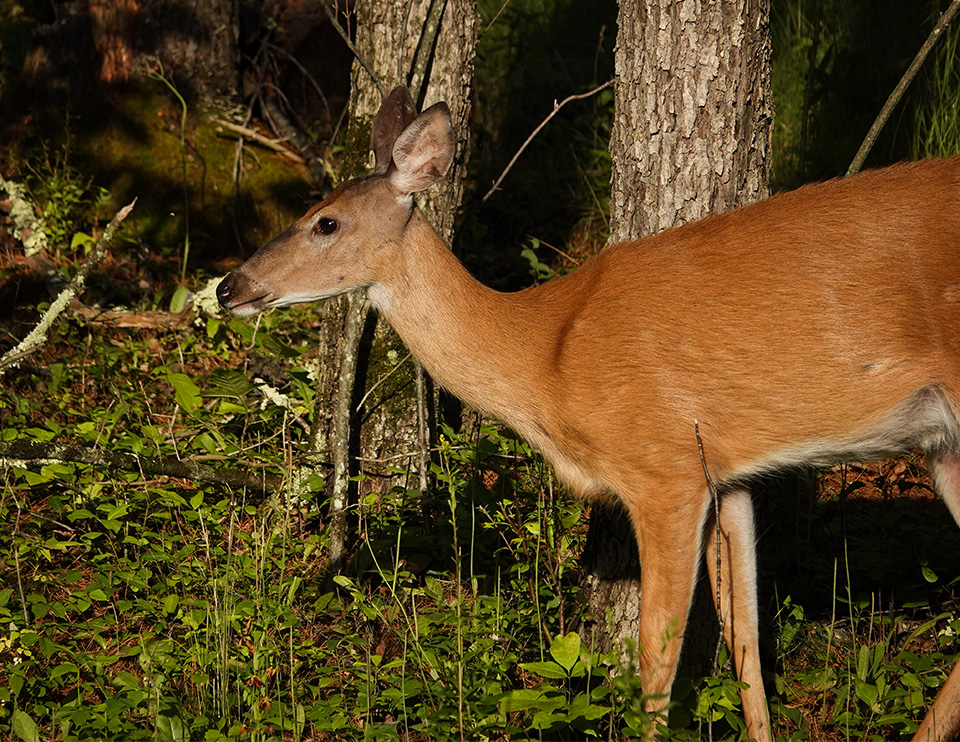
White-tailed Deer are vegetarians. They are classified as browsers: a herbivore that feeds on leaves, soft shoots, or fruits of high-growing, generally woody, plants such as shrubs. Grazers, by contrast, feed primarily on grass and other low vegetation.
An adult deer reportedly needs about five to seven pounds of food per day. For females, energy demands are highest when pregnant and lactating. For males, energy demands are highest during the fall rut. Severe winter weather increases energy demands for all individuals.
The White-tailed Deer's menu menu is extremely diverse. A selective herbivore, the White-tailed Deer browses on the most nutritious plants available. Its preferred foods include cedar, Yew, Hobblebush, Apple, Flowering Dogwood, Alternate-leaved Dogwood, Mountain Maple, and other maples.
The deer's diet varies with the season, with the animal responding to changes in plant availability.
- A 2011 review of White-tailed Deer diets in the Northeast (Hewitt, 2011) concluded that their spring diet consists of 44% browse, 36% forbs, 12% grass, and 8% lichens and fungi.
- The summer diet is somewhat different, consisting of 45% browse, 21% forbs, 22% mast, 5% grass, 2% agricultural crops, 3% lichens and fungi, and 2% other items. Whitetails in our area also feed on aquatic plants in summer.
- In fall, the pattern shifts somewhat, with the diet consisting of 38% browse, 10% forbs, 24% mast, 4% grass and 19% lichens and fungi. Soft mast (fruits) are a major component of White-tailed Deer diets in late summer and fall. One study found that fruits (mainly apples) comprised over 60% of the volume of rumen samples collected from road-killed deer in an area where apples were available.
- Most of the White-tailed Deer's fair-weather menu items have disappeared by deep winter, when browse comprises 91% and forbs only 2% of the diet. Northern White Cedar is a favorite browse of White-tailed Deer in winter. Other preferred winter deer foods include Hobblebush, Staghorn Sumac, and Basswood.
White-tailed Deer: Reproduction and Family Life
The White-tailed Deer is a prey species. Its strategy for dealing with high predation mortality is a high reproductive rate. The deer's breeding season (rut) is in the late autumn to early winter, when bucks pursue and court individual does. The timing is linked to photo period, with shortening day length triggering a chain of hormonal changes. Whitetails in the southern US breed as late as January or February. Whitetails in the northern regions of the US tend to breed in November. The peak of the breeding season in the Adirondacks is reported to be November 10.
The timing of the rut is crucial in northern climates. In places like the Adirondack Mountains, where winters are harsh, fawn survival depends on a short, precisely timed breeding season. Fawns born too early in the spring are at risk because of exposure to freezing temperatures at a time when the mother can't provide sufficient milk because the spring growth of vegetation has not yet begun. Fawns born too late don't have time enough to achieve sufficient body growth to make it though severe winter conditions.
After a gestation period of about 202 days, the fawns, weighing about 3-6 pounds, are born in late May or early June. Does usually give birth to twins, with females bred as yearlings bearing one fawn. In the first few weeks of their lives, the fawns are extremely vulnerable to a variety of predators. Their main defense is their spotted coats and their instinct to remain motionless on the ground when danger approaches.
Parental care is provided exclusively by the female. The fawns spend most of their time hidden in vegetation while the mother forages, returning to nurse them once or twice daily. Fawns reportedly begin nibbling on vegetation by 2-3 weeks of age, but most will not be fully weaned until three or four months. Even after weaning is complete, they will remain with the mother well into the fall and winter. Female fawns may stay with their mothers for up to two years.
White-tailed Deer: Behavior
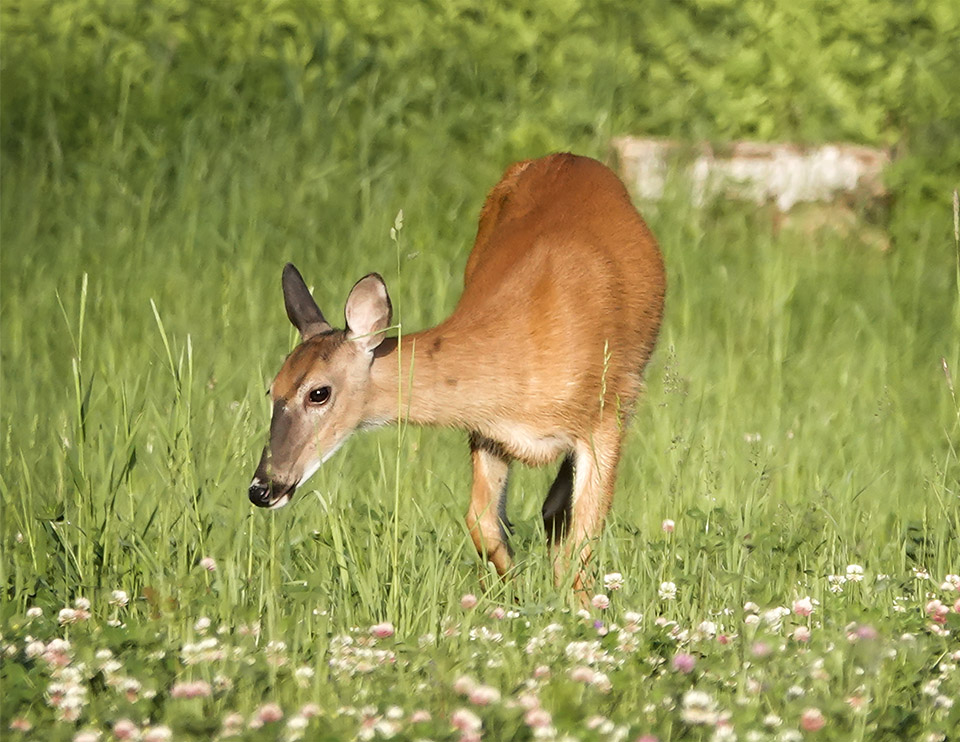
Activity Patterns:
The White-tailed Deer's activity patterns depend on the season. Deer are primarily crepuscular (active at twilight) in the spring, but are active during the hours of daylight as well in the summer, including midday. With the beginning of the rut in late fall and throughout the breeding season, activity occurs at all times during the day and night. During the winter, foraging activity is more likely in the late afternoon.In all seasons, inclement weather reduces activity, with somewhat more movement just before and after storms. When inactive, deer stand quietly or bed down in cover.
Social System and Communication:
White-tailed Deer form two basic social groups.- Female White-tailed Deer in northern forest regions, including the Adirondacks, form family or matriarchal groups consisting of older females and their female offspring. These multi-generational matriarchies use the same summer ranges year after year, with the vast majority of females retaining the summer range of their kin group.
- Males, by contrast, disperse from their natal range, but may become part of loose-knit bachelor groups of varying size.
White-tailed Deer communicate in a variety of ways, including scent, visual displays, and vocalization. Males in rut rub their antlers on saplings or trees and create scrapes of about three feet in diameter to mark territories. White-tailed Deer also have an extensive repertoire of body language. When faced with a possible predator, the deer's body becomes tense and rigid. If the deer is alarmed, but cannot identify the source of its suspicion, it might stamp its foot and snort. If really alarmed, the deer lifts its tail and flashes the white underside as it bounds away.
Deer Yards:
Although White-tailed Deer living in areas of mild winters usually inhabit the same range throughout the year, deer in areas with severe winters, like the Adirondacks, migrate from their summer ranges to winter ranges in the fall, usually in late November or December. The timing depends on the weather and is said to be triggered by snow fall and cold temperatures. In the Adirondack Park, migration to traditional winter ranges, called deer yards, begins when snow depth reaches about 15 inches. Most Adirondack deer migrate, since only an estimated 12 to 13% of the warm-weather range is usable in winter.To reach their winter ranges, deer travel rapidly for up to twelve miles, often in less than 24 hours. They travel along well-defined trails, congregating in deer yards which typically consist of closed-canopy coniferous forests. These areas provide protection from the wind and decreased snow depths compared to nearby areas. Stands of mature Northern White Cedar are a preferred forest type, because this species offers thermal protection and is a preferred winter browse.
In the Adirondacks, deer begin abandoning their winter ranges from mid-March through April. Movement back to the summer ranges is linked to the decreasing frequency of severe wind chill. By April and May, our Adirondack deer are back on their summer-fall ranges.
White-tailed Deer: Mortality and Predators
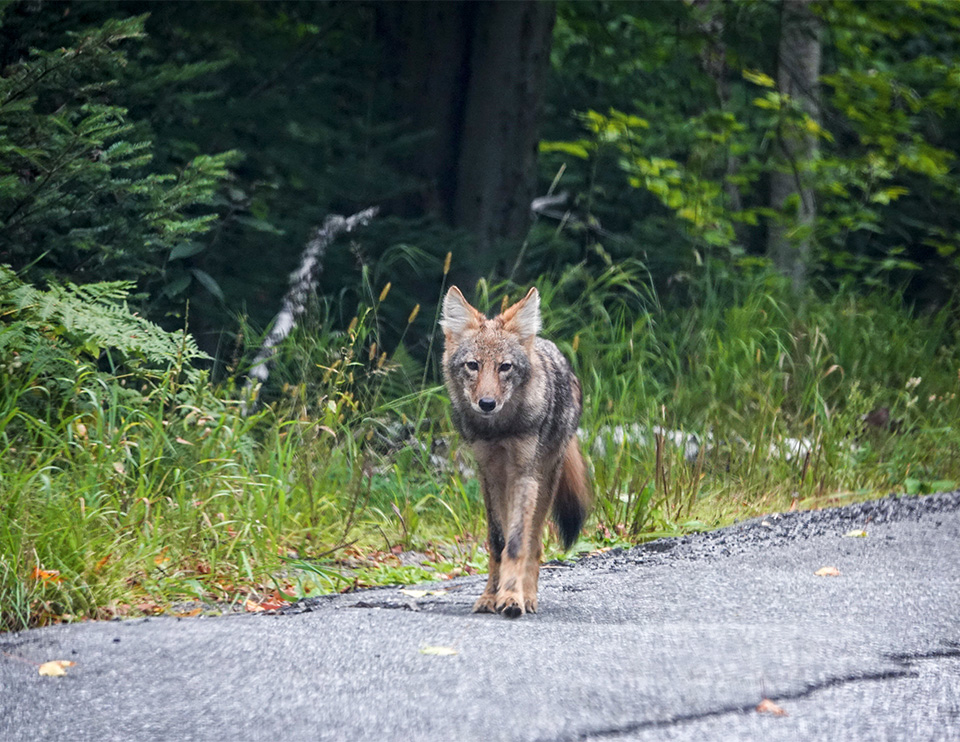
The White-tailed Deer is an important prey species throughout its range, including in the Adirondack region. One of the key predators is man. Hunters in the Adirondacks can kill deer with a bow, crossbow, muzzle loader, handgun, shotgun, and rifle. The hunting season in our region (depending on the weapon used) extends from late September through early-December.
In New York State, hunters are required to tag their deer and report the kill online within seven days, so the counts of deer death due to hunting are fairly accurate. In 2017, the New York State Department of Conservation's deer harvest estimate indicates that hunters in the state killed a total of 203,427 deer (including fawns). The majority of deer killed were in the southern zone; only 25,351 deer (adults and fawns) were killed in the northern zone, with the fewest kills per square mile in the Adirondack region.
Collisions with motor vehicle represent another significant human-related mortality factor. The number of deer killed in road accidents has been estimated to range from 500,000 to 1.5 million annually in the US, with most accidents occurring at dawn, dusk, or after dark. In New York State, the Department of Transportation estimates that there are 60,000 to 70,000 deer-vehicle collisions each year.
Wild predators also take a toll on the deer population. The list of wild predators of White-tailed Deer is headed by the Eastern Coyote. White-tailed Deer represent a frequent prey item for Eastern Coyotes, especially in winter and in spring, when significant numbers of fawns are taken during the first few weeks of life when they are most vulnerable to predation.
The extent to which Eastern Coyotes affect the deer populations in the Adirondacks is a matter of some controversy.
- Studies of coyote foraging ecology in the Adirondack region done in the last of the 20th century found that deer played the dominant role in coyote menus.
- More recent research of coyote diets in the Adirondacks suggests that the relative importance of White-tailed Deer in the Eastern Coyote's diet had decreased, with an increasing role in the coyote's menu played by American Beaver and Snowshoe Hare.
- Research in other parts of New York State suggests that much of the venison consumed by Eastern Coyotes is carrion, although it remains to be seen if this conclusion applies to Eastern Coyotes in the Adirondacks.
Other wild predators of deer include Bobcats, American Black Bear, and foxes. These predators are capable of killing fawns in spring. The Bobcat reportedly can also bring down winter-weakened adult deer, but the impact on deer populations is small, because the Bobcat population is small.
In winter, malnutrition is the leading cause of White-tailed Deer deaths in the Adirondacks. When snow is above 16 inches in depth, it greatly restricts the deer's movement. A study of an unhunted population of White-tailed Deer in the central Adirondacks found that deer populations fluctuated widely with winter severity, the main factor being the length of time the deer were confined to their winter range.
Although White-tailed Deer in captivity are a relatively long-lived species – the average lifespan of captive deer is 16 years – few wild deer make it for more than two or three years. In the Adirondacks Wildlife Management Unit, virtually all of the adult bucks killed during the 2017 deer hunting season were 3½ years old or younger. About half of these young bucks were only 1½ years old.
White-tailed Deer: Distribution
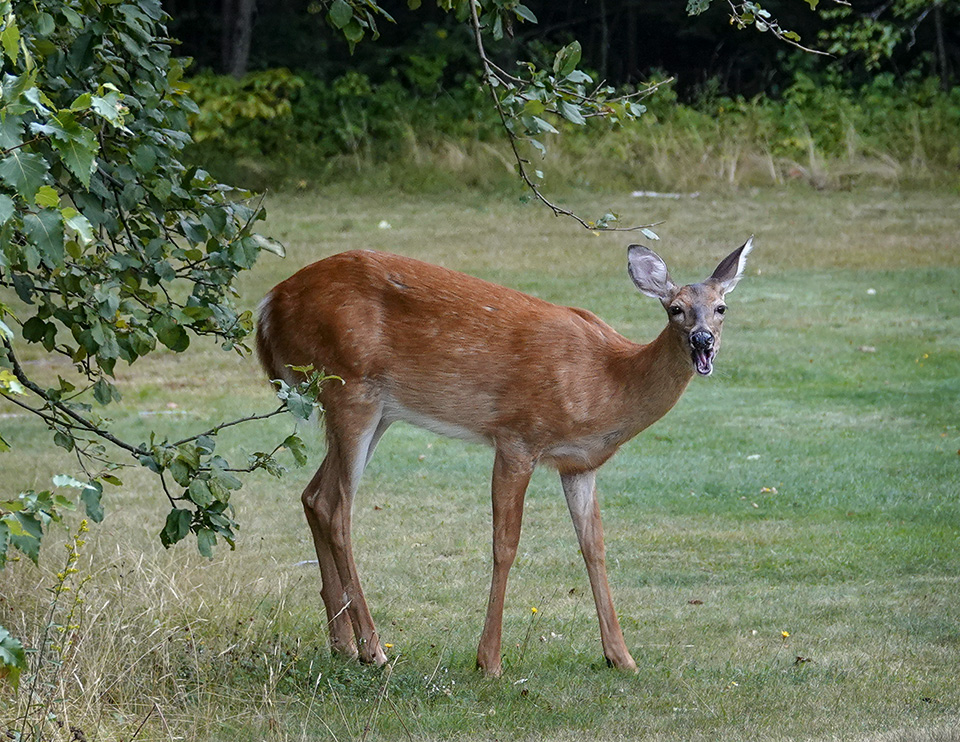
The White-tailed Deer is native to North America, Central America, and South American. Its range extends from southern Canada south to northern South America. In the US, it is present in 45 states. The species is absent in Utah and rare in Nevada and California.
White-tailed Deer populations have changed significantly since the colonization of North America.
- Before European colonization, deer populations in North America are estimated to have ranged from 23.6 to 32.8 million. In the Adirondacks during the precolonial period, the deer population in precolonial days is said to have been minimal, because the region was covered by mature forest not congenial to whitetails. Deer density in the area immediately adjoining the Adirondack Mountains is estimated to have been higher than in the central part of the region.
- By 1800, the deer population in North America had been cut to about half, due to habitat changes and a shift from subsistence hunting to market hunting by both Native American and European residents.
- Further declines in the North American deer population occurred during the 19th century, when deforestation and unregulated hunting reportedly destroyed over 95% of US deer. By 1900, only about 350,000 whitetails remained.
- White-tailed Deer populations rebounded in the 20th century throughout North America, including in New York State. Deer management efforts in New York, combined with habitat changes favoring deer and the extirpation of the deer's largest wild predators (wolves and mountain lions), were very successful. As a result, deer overabundance, particularly in suburban and urban areas outside the Adirondack Mountains, is posing worsening problems in the form of deer-vehicle collisions, threats to agricultural crops, and increases in tick-borne illnesses such as Lyme disease.
White-tailed Deer are the most abundant large mammal in the Adirondacks. The Adirondack deer population is estimated at 60,000-80,000. By contrast, the latest population estimate for American Black Bear in the Adirondack Park is 3,000-4,000, while the results from the most recent Department of Conservation moose survey suggests an Adirondack moose population of about 400 animals.
White-tailed Deer are more numerous in the lowlands on the Park's periphery where habitat is more congenial than in the central Adirondacks and High Peaks region. Deer are not commonly found in the higher elevations (above 2500 feet).
White-tailed Deer Habitat
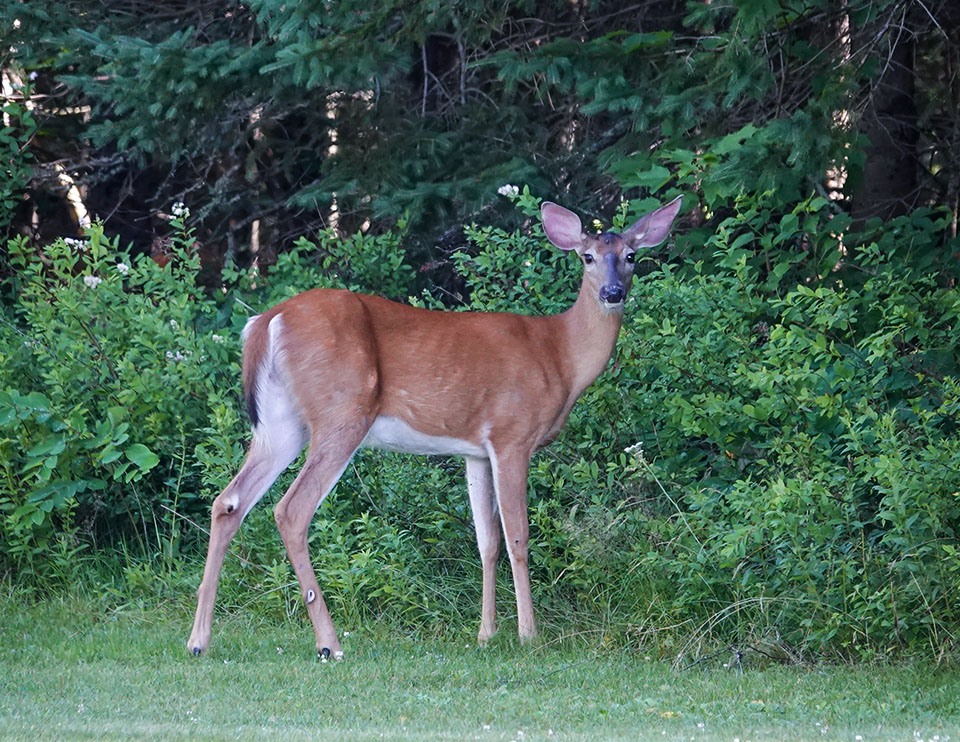
White-tailed Deer are generalists able to survive in a wide variety of habitats. The deer's habitats shifts with the season. In the winter, the White-tailed Deer's preferred habitat is mature stands of conifers that provide winter shelter, especially Northern White Cedar. Mature stands of Eastern Hemlock, Balsam Fir, and spruce are also used as deer yards.
During the rest of the year, deer are found in habitats in all stages of forest succession, brushy fields, and wooded farmlands. In the Adirondack region, during the warm-weather months, the whitetail is most at home in areas where food and cover are in close proximity. They prefer the openings and edges of deciduous and mixed forests and in the early successional stages of these forests. Deer generally benefit from forest disturbances, such as fire, logging, and weather events. They also thrive in early successional sites, such as old fields.
Where to See White-tailed Deer in the Adirondacks
Although White-tailed Deer populations are much larger outside the Adirondack Park, deer are fairly common in the Adirondack region, especially in the periphery of the Park. They can be glimpsed on many of the trails covered here, as well as in residential areas. Your best chance of a deer sighting is probably in early summer. Many of the White-tailed Deer sightings reported to iNaturalist in our region were in June.
Signs of the White-tailed Deer's presence include deer trails (often called herd paths) which result when deer use the same trails from feeding places to bedding spots. Look for these paths crossing roads and trails. Other common signs of the deer's presence include scats (often deposited on the herd paths), tracks, and bitten-off twig ands and bark. Scraped depressions and bark scraped from trees are commonly found during the fall.
Adirondack Mammal List
References
New York State Department of Environmental Conservation. White-tailed Deer. Retrieved 13 February 2019.
New York State Department of Environmental Conservation. Winter Deer Foods. Retrieved 22 February 2019.
New York State Department of Environmental Conservation. New York Hunting & Trapping. Retrieved 9 November 2019.
New York State Department of Environmental Conservation. White-Tailed Deer Harvest Summary. 2017. Retrieved 25 March 2019.
New York State Department of Environmental Conservation. Deer Management in Urban and Suburban New York. A Report to the New York State Senate and Assembly. 31 December 2018. Retrieved 28 March 2019.
New York State Department of Environmental Conservation. Deer Overabundance. Retrieved 28 March 2019.
New York State Department of Environmental Conservation. DEC Announces Completion of Annual Aerial Survey of Adirondack Moose. 8 February 2019. Retrieved 30 March 2019.
New York State Department of Environmental Conservation. Black Bear. Retrieved 30 March 2019.
New York State Department of Transportation. Deer and Moose Avoidance. Retrieved 29 March 2019.
State University of New York. College of Environmental Science and Forestry. White-tailed Deer. Retrieved 29 March 2017.
C.W. Severinghaus and C.P. Brown, "History of the White-tailed Deer in New York," New York Fish and Game Journal. Volume 3. Number 2 (July 1956), pp. 129-167. Retrieved 9 November 2019.
Robin J. Innes , "Odocoileus virginianus," in Fire Effects Information System (FEIS). Species Reviews. Forest Service, Rocky Mountain Research Station, Fire Sciences Laboratory (United States Department of Agriculture, 2013). Retrieved 20 January 2019.
Winston Paul Smith, "Odocoileus virginianus," Mammalian Species, Number 388 (6 November 1991), pp. 1-13. Retrieved 29 March 2017.
Integrated Taxonomic Information System On-line Database. Odocoileus virginianus. Retrieved 23 March 2019.
S. Gallina and Lopez Arevalo, H. 2016. Odocoileus virginianus. The IUCN Red List of Threatened Species 2016. Retrieved 23 March 2019.
University of Michigan. Animal Diversity Web. Odocoileus virginianus. Retrieved 23 March 2019.
D. Andrew Saunders. Adirondack Mammals (Adirondack Wildlife Program. State University of New York. College of Environmental Science and Forestry, 1988), pp. 202-208.
William K. Chapman. Mammals of the Adirondacks. A Field Guide (North Country Books, 1991), pp. 116-118, Plates 21-23.
John O. Whitaker, Jr. and William J. Hamilton, Jr. Mammals of the Eastern United States. Third Edition (Cornell University Press, 1998), pp. 531-541.
William J. Hamilton and John O. Whitaker, Jr. Mammals of the Eastern United States. Second Edition (Cornell University Press, 1979), pp. 316-320. Retrieved 9 February 2019.
iNaturalist. Adirondack Park Sightings. White-tailed Deer. Odocoileus virginianus. Retrieved 24 March 2019.
iNaturalist. Adirondack All-Taxa Biodiversity Inventory. White-tailed Deer. Odocoileus virginianus. Retrieved 24 March 2019.
Alexander C. Martin, Herbert S. Zim, and Arnold L. Nelson. American Wildlife & Plants. A Guide to Wildlife Food Habits (Dover Publications, 1951), pp. 11, 268-270, 290-294, 299-311, 316, 349-350, 353-354, 321-331, 334-335, 337-340, 343-346, 350-352, 356-357, 359-365, 402-403, 416-426, 362. Retrieved 12 February 2019.
James M. Ryan. Adirondack Wildlife. A Field Guide (University of New Hampshire Press, 2008), pp. 214-216.
Donald W. Stokes and Lillian Q. Stokes. A Guide to Animal Tracking and Behavior (Little, Brown and Company, 1986), pp. 16, 56-57, 70-71, 74-75, 80-81, 94-95m 104-107, 382-392.
William Henry Burt. A Field Guide to the Mammals of North America North of Mexico. Third Edition (Houghton Mifflin Company, 1980), p. 218, Plate 23. Retrieved 12 February 2019.
National Geographic Society.Wild Animals of North America. Revised Edition (National Geographic Society, 1995), pp. 330-335. Retrieved 22 March 2019.
Adrian Forsyth. Mammals of North America. Temperate and Arctic Regions (Firefly Books, 1999), pp. 314-315.
Richard M. DeGraaf and Mariko Yamasaki. New England Wildlife: Habitat, Natural History, and Distribution (University Press of New England, 2001), pp. 357, 421, 448. Retrieved 3 February 2019.
Karl V. Miller, Lisa I. Muller and Stephen Demaris, "White-tailed Deer," in George A. Feldhamer, Bruce C. Thompson, and Joseph A. Chapman (Eds). Wild Mammals of North America: Biology, Management, and Conservation. Second Edition (The Johns Hopkins University Press, 2003) pp. 906-930.
Clinton Hart Merriam. The Vertebrates of the Adirondack Region, Northeastern New York (Press of L.S. Poster, 1882), pp. 29-39, 42-44. Retrieved 2 March 2017.
Clinton Hart Merriam. The Mammals of the Adirondack Region, Northeastern New York (Self-published, 1884), pp. 107-138. Retrieved 2 March 2017.
Wallace R. Skinner and E. S. Telfer, “Spring, Summer, and Fall Foods of Deer in New Brunswick,” The Journal of Wildlife Management, Volume 38, Number 2 (April 1974), pp. 210-214. Retrieved 18 January 2019.
William L. Webb, “Summer Browse Preferences of Adirondack White-Tailed Deer,” The Journal of Wildlife Management. Volume 23, Number 4 (October 1959), pp. 455-456. Retrieved 18 January 2019.
Claude Daigle et al. "Summer Diet of Two White-tailed Deer, Odocoileus virginianus, Populations Living at Low and High Density in Southern Québec," The Canadian Field-Naturalist, Volume 118, Number 3 (2004), pp. 360-367. Retrieved 30 August 2018.
Eugenia V. Bragina, Roland Kays, Allison Hody, Christopher E. Moorman, Christopher S. Deperno, and L. Scott Mills, "Effects on White‐tailed Deer Following Eastern Coyote Colonization," The Journal of Wildlife Management, 20 March 2019. Retrieved 22 March 2019.
Scott A. Warsen. Evolving Niche Of Coyotes In The Adirondack Mountains of New York: Long-Term Dietary Trends and Interspecific Competition. A thesis submitted in partial fulfillment of the requirements for the Master of Science Degree State University of New York, College of Environmental Science and Forestry (Syracuse, New York. May 2012). Retrieved 18 January 2019.
Robert E. Chambers, Peter Gaskin, Roger A. Post, and Stuart Cameron, "The Coyote," New York State Conservationist, Volume 29, Number 2 (October-November 1974), pp. 5-7. Retrieved 9 November 2019.
G.C. Brundige. Predation Ecology of the Eastern Coyote (Canis latrans var.) in the Central Adirondacks, New York. Ph.D. Dissertation, State University of New York, College of Environmental Science and Forestry, Syracuse, 1993. (Abstract only) Retrieved 10 February 2019.
Jacqueline Frair, James Gibbs, Gordon Batcheller, and Paul Jensen. Population Status and Foraging Ecology of Eastern Coyotes in New York State (2014). Retrieved 10 January 2019.
Jacqueline Frair. Top Dog? Exploring the Ecological Role of Coyotes in NY. Northeastern States Research Cooperative Webinar. 11 November 2015. Retrieved 22 February 2019.
John F. Benson, Karen M. Loveless, Linda Y. Rutledge, Brent R. Patterson, "Ungulate Predation and Ecological Roles of Wolves and Coyotes in Eastern North America," Ecological Applications, Volume 27, Number 3 (April 2017), pp. 718-733. Abstract. Retrieved 24 February 2019.
Maggie Bordas, Niche Alteration and Range Expansion of the Eastern Coyote (Canis latrans): An Examination of Predator Ecology. 2016. Retrieved 19 February 2019.
Robert E. Chambers, "Diets of Adirondack Coyotes and Red Foxes," Transactions of the Northeast Section, the Wildlife Society, Volume 44 (1987), p. 90.
Kelly F. Robinson, Duane R. Diefenbach, Angela K. Fuller, Jeremy E. Hurst And Christopher S. Rosenberry, "Can Managers Compensate for Coyote Predation of White-Tailed Deer?" The Journal of Wildlife Management, Volume 78, Number 4 (May 2014), pp. 571-579. Retrieved 10 February 2019.
David G. Hewitt, "Nutrition," in David G. Hewitt (Ed.). Biology and Management of White-tailed Deer (CRC Press, 2011), pp. 75-105.
Donald F. Behrend. Behavior of White-tailed Deer in an Adirondack Forest. Ph.D. Dissertation (SUNY ESF, 1966). Abstract. Retrieved 23 March 2019.
William C. Tierson, George F. Mattfeld, Richard W. Sage, Jr. and Donald F. Behrend, "Seasonal Movements and Home Ranges of White-Tailed Deer in the Adirondacks," The Journal of Wildlife Management, Volume 49, Number 3 (July 1985), pp. 760-769. Retrieved 14 February 2019.
John Pearce, "The Effect of Deer Browsing on Certain Western Adirondack Forest Types," Roosevelt Wildlife Bulletin, Volume 7, Number 1 (October 1937), pp. 7-61. Retrieved 22 March 2018.
M. T. Townsend and M. W. Smith, "The White-tailed Deer of the Adirondacks," Roosevelt Wild Life Bulletin, Volume 6, Number 2 (October 1933), pp. 161-326. Retrieved 22 March 2018.
D. F. Behrend, "Correlation of White-tailed Deer Activity, Distribution and Behavior with Climatic and Other Environmental Factors," (1966). Adirondack Wildlife Research Project Reports Funded by the Pittman-Robertson Act (1966) Paper 6. Retrieved 23 March 2019.
Jeremy E. Hurst and William F. Porter, "Evaluation of Shifts in White-Tailed Deer Winter Yards in the Adirondack Region of New York," The Journal of Wildlife Management, Volume 72, Number 2 (February 2008), pp. 367-375. Retrieved 14 February 2019.
Stacy A. McNulty, William F. Porter, Nancy E. Mathews and Jennifer A. Hill, "Localized Management for Reducing White-Tailed Deer Populations," Wildlife Society Bulletin (1973-2006), Volume 25, Number 2 (Deer Overabundance. Summer 1997), pp. 264-271. Retrieved 14 February 2019.
Anne M. Oyer and William F. Porter, "Localized Management of White-Tailed Deer in the Central Adirondack Mountains, New York," The Journal of Wildlife Management, Volume 68, Number 2 (April 2004), pp. 257-265. Retrieved 14 February 2019.
Glenn H. Morton and E. L. Cheatum, "Regional Differences in Breeding Potential of White-Tailed Deer in New York," The Journal of Wildlife Management, Volume 10, Number 3 (July 1946), pp. 242-248. Retrieved 14 February 2019.
Joshua L.B. Pierce, Sabrina A. Dalinsky, Andre-Anne Chenaille, Lewis M. Lolya, Jennifer L. Maguder, Chloe Mattilio, Grace V. Mayhew, Erin Regan and David A. Patrick, "Scale-dependent Effects of Coyote-predation Risk on Patterns of White-tailed Deer Browsing Along Linear Forest Edges," Northeastern Naturalist, Volume 22, Number 2 (2015), pp. 262-272. Retrieved 10 February 2019.
Richard W. Sage, Jr, "Seasonal Movements and Ranges of White-tailed Deer in the Adirondacks," Adirondack Wildlife Research Project Reports Funded by the Pittman-Robertson Act. (1982) Paper 11.
Jocelyn L. Aycrigg and William F. Porter, "Sociospatial Dynamics of White-Tailed Deer in the Central Adirondack Mountains, New York," Journal of Mammalogy, Volume 78, Number 2 (May 1997), pp. 468-482. Retrieved 10 February 2019.
Keith L. Bildstein, "Why White-Tailed Deer Flag Their Tails," The American Naturalist, Volume 121, Number 5 (May 1983), pp. 709-715. Retrieved 26 March 2019.
Richard W. Sage, Jr., William F. Porter, and H. Brian Underwood, "Windows of Opportunity: White-tailed Deer and the Dynamics of Northern Hardwood Forests of the Northeastern US," Journal for Nature Conservation, Volume 10, Issue 4 (December 2003), pp. 213-220. Retrieved 31 March 2019.
George Earl, " Debate over deer," Adirondack Explorer, 3 January 2011. Retrieved 28 March 2019.
Tom Kalinowski, "Prime Time for Hunting Whitetail Deer," Adirondack Almanack, 5 November 2012. Retrieved 28 March 2019.
Paul Hetzler, "Understanding the Life Span of Whitetail Deer," Adirondack Explorer, 29 May 2016. Retrieved 28 March 2019.
Tom Kalinowski, "Deep Snow and White-Tail Deer Mortality," Adirondack Almanack, 12 March 2011. Retrieved 28 March 2019.
Tom Kalinowski, "Whitetail Deer: Shedding Antlers," Adirondack Almanack, 1 January 2013. Retrieved 28 March 2019.
Tom Kalinowski, "When Whitetail Deer Antlers Lose Their Velvet," Adirondack Almanack, 3 September 2012. Retrieved 28 March 2019.
